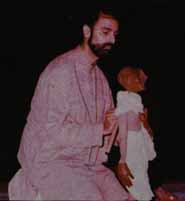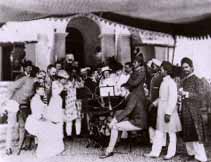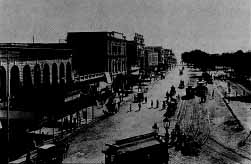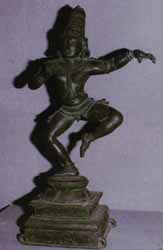Rock Art Unit
- Seminar on ‘What have the Arts in common ?’
- A Sympositum on ‘Future of the Mind : Mind of the Future”
- IGNCA Pays Tribute to Gandhiji…
- ‘The Legacy of Raja Deen Dayal’
- A Glimpse into our Heritage”: Exhibition and a Seminar on Brhadisvara
- What is New in Rock Art?
- Exhibition : ‘Deer, Early Images: Indian and Europe’ Mati Ghar, IGNCA December 7 – January 7, 1993-94
SEMINAR, EXHIBITIONS
| Seminar on ‘What have the Arts in Common?’
3-5 June 1993, Dhvanyaloka, Mysore A Seminar on ‘What have the Arts in Common?’ was held in Mysore from 3-5 June 1993 jointly sponsored by IGNCA and Dhvanyaloka, Mysore. The Seminar focused on the fundamental issued relating to the arts and covered a wide spectrum of areas including creativity, self expression, functions, manifestation and response in art to the inter-relationship between the various genres in art. The Seminar was attended by thirty-five delegates, including mainly practitioners and theorists representing several art disciplines. Organized in nine sessions and spread over three days, the Seminar was interspersed with lively panel discussions and also dance and music performances. Inaugurating the seminar, Shivaram Karanth, the eminent scholar and creative writer, spoke on the nature of creativity and related it to its own career as a writer. In the keynote address Kapila Vatsyayan spoke about the complex web of interrelationship in art. The theoretical and practical dimensions of art and artistic traditions in India, and the world-view embodied in them which runs as a central thread connecting the parts to the whole, was the subject of her presentation. The participants included Raja Ramanna, Mulk Raj Anand, C.D. Narasimhaiah, Padma Subramanian, S.C. Malik, R.K. Laxman among others. The meeting of interdisciplinary scholars with seemingly different occupations and preoccupations turned out to be a collective pursuit for identifying the perennial source-springs of art activity on the one hand, and the commonality and reciprocity of the arts on the other.
|
| A Symposium on ‘Future of the Mind: Mind of the Future’
New Delhi: 23-26 August 1993 IGNCA, in collaboration with Indian Council for Cultural Relations (ICCR) organized a Symposium ‘Future of the Mind: Mind of the Future’ at India International Centre, New Delhi. Held as the inaugural event under the ‘Information 2000+’ programme of the Indo-US Sub-Commission on Education and Culture, the meeting discussed the effects of the technological revolution, and was attended by a panel of eminent philosophers and scientists from India and USA. The symposium was inaugurated by Shri Ram Niwas Mirdha, Co-Chairman, Indo US Sub-Commission on Education and Culture on 23 August 1993. While the keynote address was delivered by Dr. Israel Rosenfield, of Department of History, State University of New York, the Valedictory address was given by Swami Jitatmananda, President, Ramkrishna Ashram, Rajkot. Dr. Kapila Vatsyayan summed up the deliberations of the meeting. The Symposium addressed itself to the relationship of the computer to the brain, artificial intelligence, memory and consciousness, new developments in the field of Neuro-science, Neuro-anatomy and Neuro-physiology and the implications of "virtual reality". The discussions, spread over different sessions during the four days, centered on the questions concerning the nature of the mind, nature of knowledge, understanding, wisdom & spirituality, and the role of consciousness in quantum mechanics.
|
| IGNCA Pays Tribute to Gandhiji…. Puppet Exhibition – October 1993
|
|
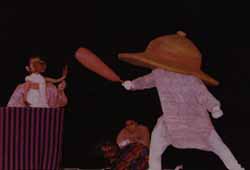 |
|
|
|
|
|
|
|
| ‘The Legacy of Raja Deen Dayal’ Mati Ghar, IGNCA 5 October – 7 November 1993
Recently IGNCA mounted an exhibition of the photographs of Raja Lala Deen Dayal, India’s most accomplished photographer of the nineteenth century. The exhibition displayed the photographs and work equipment of Raja Deen Dayal, which are now part of IGNCA’s own collection, acquired from the family of Deen Dayal himself. Raja Deen Dayal (1844-1905) was a professional photographer who received the patronage of the Maharaja of Indore, Lord Dufferin as well as the Nizam of Hyderabad. He was a master camera artist who has given us glimpses into his contemporary society, from the lives of Indian princes and the British raj, to those of folk and tribal people, monuments, archaeological sites, architectural heritage – in short vignettes from a cross section of the life around him. His photograph offer us vivid insights into India’s rich cultural heritage and are also valuable testimonials for historians. As a leading exponent of photography, Den Dayal was awarded many titles and honours during his time including a Royal Warrant from Queen Victoria. He also set up his own flourishing business as a photographer. IGNCA’s exhibition, titled ‘The Legacy of Raja Deen Dayal’ was mounted from the glass plate negatives of the master photographer. The exhibition was broadly though fluidly arranged in three sections: The Place, The People and The Event. These covered respectively the physical setting, the individuals and the happenings and activities, which the photographer perceived as his raw material. The central rotunda of the exhibition was devoted to the photographer himself. On 5 October 1993 the exhibition was inaugurated in the premises of C.V. Mess, IGNCA by Shri H.Y. Sharda Prasad. Dr. Kapila Vatsyayan welcomed the distinguished guests and presented the context of the exhibition, while Mr. T. Kasinath spoke on Raja Deen Dayal, the man and his work. Shri Sharada Prasad’s inaugural address was an invitation to the exhibition itself. Here are some excerpts from his speech:
|
 |
|
|
|
|
| Who is master?
A master, to use cyclical reasoning, is one who makes masterpieces, which in turn make him a master! In literary criticism and writing on art we come across the word classic. A classic is not easy to define but it describes work of art, which has stood the judgement of at least three or four generations. There are many books, many paintings, which win instant acclaim, but, like a comet, which dazzles, their brilliance fades fast and they are forgotten tomorrow. Anybody is immortal for five minutes, as they say in our age of television. But a classic endures. Sometimes it is neglected and unrecognized in the lifetime of its creator but later ages discover its worth. What applies to an individual classic applies to a master artist. Raja Deen Dayal had the good fortune to win praise when he was still young (The Graphic of London gave him three pages when he was only 33) and be acclaimed by successive generations – so much so that we have statements like ‘photography in Indian in the nineteenth century is just one individual – Deen Dayal’. An article on a Deen Dayal exhibition in London was titled ‘Photograph’s Peerless Patriarch’. The critic Dnyaneshwar Nadkarni described him as ‘Lensman extraordinary’. Prof. Galbraith in a foreword to a book of Deen Dayal’s photographs went as far as to say that Mahbub Ali, Nizam VI, by appointing Deen Dayal as his court photographer, ensured his own rescue… In is not the pen or the typewritten or the word processor that produces literature, not the brush that paints. It is no the lens or the camera that takes a photograph, but the man behind it. When we speak of the camera eye, what we really mean is a photographer’s eye behind the camera. The great practitioner of photography, Edward Steichen, has said of his art: "Photography is a dynamic process giving form of ideas and explaining man to man". Deen Dayal explained not only people but our environment, our cultural heritage to people – his contemporaries as well as future generations. He was a great portraitist who saw into the soul of the people who faced him. He was also a great social historian, as he had great curiosity in all that happened in his time and recorded it for future generations. He had a special feel for places and their visual beauty and the atmosphere they exuded… In all that he did, Deen Dayal saw the outer world and the inner world… Dr. Vatsyayan has already explained how the IGNCA came to acquire a substantial portion of Raja Deen Dayal’s negatives from his family. There must be hundreds more of his photographs in private collections and in museums here and abroad. I take this opportunity to appeal to these owners to share their collections with us for display in the further exhibitions of Deen Dayal’s work we shall be organizing and the series of monographs we shall be organizing and the series of monographs we propose to publish as a national homage to this great master.
|
| "A Glimpse into Our Heritage": Exhibition and a Seminar on Brhadisvara
Madras, October-November 1993 |
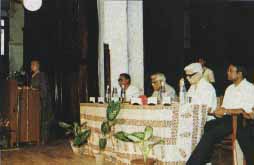 |
|
 |
|
|
Both the Exhibition and Seminar on Brhadisvara were inaugurated by Sh. R. Venkataraman, former President of India. In the Presidential address, Dr. S. Gopal observed that "in its mass, scale, balance, symmetry and dimension, the Brhadisvara temple is second to none". Dr. Kapila Vatsyayan, Academic Director, IGNCA welcoming the distinguished guests and participants, introduced the Brhadisvara project in which multi-disciplinary research is going on since 1988. She emphasized that the temple is not merely an archaeological structure, but is an important, living entity which has been preserved down the generations in a more or less intact form. The seminar, divided into three parts – Documentation, Perception and Interpretation – was attended by thirty scholars representing varied disciplines, such as Architecture, Epigraphy, Art History, Musicology, Dance, etc. Mr. P. Pichard spoke on the Brhadisvara temple architecture, while Mr. Anup Dave dwelt on the town and temple layout. Dr. Champakalakshmi offered the historical interpretation, Dr. R. Triumalai revealed the socio-economic conditions evident from Tanjore inscriptions. Dr. Padma Subrahmanyam spoke on the dance traditions associated with the Tanjore temple, and Shri B.M. Sundram threw light on temple music. The lectures were supplemented by Tevaram recitals, the screening of a film (based on IGNCA’s collection of Sadagopan’s films) on Kancheepuram Paramacharyal in Temple festivals, and dance demonstration by Tanjore Kittappa Pillai and his disciples. An Agama text Aghora Sivacharya Paddhati translated by Prof. S.S. Janaki was released on the occasion. The valedictory address was given by Shri T.V. Venkataraman, Chief Secretary of Tamil Nadu. The exhibition was widely covered by the press and greatly appreciated by the visitors. Described as ‘a glimpse into our heritage’ and ‘a unique event’, the seminar and the exhibition underscored the importance of an integrated study on the cultural heritage of India. In his inaugural address of the Seminar on Brhadisvara, Shri R. Venkataraman spoke on the need for an integrated study on the temple. Here are some excerpts from his speech:
|
|
|
|
|
I am afraid that a project of this kind cannot achieve its aims by a mere data-collection and reproduction. Nor is it possible to bring out the integrity of the arts and above all the integrity of the symbolism and its content and of all human endeavour coevals with life. There is a fundamental basis of our art and culture. They are embedded in the unity of life and seek to consciously ascend to the heights of experiences where the form and the concept completely merge and become part of the great Void. This is symbolized by rising power of the Brahadisvara temple.
|
|
| What is New in Rock Art?
Recently a twin programme of a Seminar and an Exhibition on Rock Art was organized by IGNCA under the aegis of UNESCO. Seminar: ‘Global Conference on Rock Art’ IGNCA, 29 November – 7 December 1993 Primeval man’s unbridled creative urge manifested itself in the form of rock paintings, bruising and engravings, which are found scattered all over the world. Rather than categorizing these rock art sites as the cultural property of particular nations where they are found, these sites should be deemed as the collective heritage of humanity. In its programme of research and documentation, IGNCA has adopted a holistic approach on rock art, by inter-linking it with the living arts of India as well as those of other cultures. During the past five years, IGNCA has done wide documentation on rock art and in collaboration with the French experts is at present consolidating a fresh outlook on the subject. With this dynamic and integral approach, IGNCA held a Global Conference on Rock Art, which attracted Rock Art specialists from all over the world, such as Argentina, Australia, Bolivia, Canada, China, Czech Republic, England, France, Germany, Italy, Kenya, Makedonija, Portugal, Russia, Saudi Arabia, Slovakia, Spain and USA. The insights generated by this crucial global meeting would help IGNCA in its conceptual plan of developing a gallery of primeval sight (Adi Drsya). The plenary session of the seminar was held at National Museum on 29 November, and the concluding session on 7 December at IGNCA. The seminar was organized with two sessions running concurrently everyday. The major themes, grouped under nine sessions, were as follows:
|
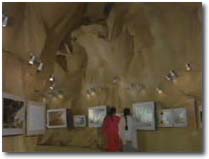 |
|
| Keeping in tune with the concept of the proposed gallery ‘Adi Drsya’, the Exhibition focuses on perceptions on nature and life through time and space. it highlights the significance of rock art in contemporary life by its relation to the existing traditions of indigenous art. A host of common animal forms, wild as well as domesticated, have survived in these ‘dateless’ art manifestations across the world. One such commonly found motif is that of the deer, and irrespective of the species or environmental variations, the deer has attracted the imagination of man from time immemorial.
The present exhibition attempts to recreate the original setting of rock art with optimum approximation; it displays reproduction in the form of photographs, slides, linedrawings, water-colours and the like. Starting with the contemporary naturl environment of deer as found in the different parts of India, the exhibition of deer as found in the different parts of India, the exhibition also highlights the continuity of the deer motif in pottery, the Sanchi panel and contemporary tribal art objects. To emphasise the timelessness of tradition, live demonstrations of Warli wall paintings are also depicted. |
|
[ Newsletter | List of Newsletter ]





